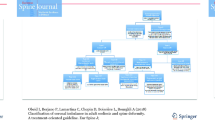Abstract
Fractures of the thoracolumbar junction can lead to regional kyphosis, this being a significant cause of pain and disability for the patients. After a traumatic fracture of the thoracolumbar spine, early or late regional kyphosis can be observed. This post-traumatic deformity can, however, be corrected with appropriate surgical methods. Posterior tricolumnar osteotomies are some of the most powerful methods of correction and are particularly indicated when sagittal and coronal deformities have to be simultaneously corrected or when anterior surgery is not possible. Anterior corpectomy and lengthening with posterior instrumentation are, however, an alternative technique to restore the anterior column support and to correct the regional kyphotic deformity and an option for appropriate sagittal balance restoration and control of symptoms. Proper surgical technique, evaluation of the bone quality and identification of eventual extension of the deformity to the thoracic spine are key aspects in prevention of failures.



Similar content being viewed by others
References
Tay BKB, Eismont F (2002) Cervical spine fractures and dislocations. In: Fardon DF, Garfin SR, Abitbol JJ, et al. (eds) Orthopaedic knowledge update: spine 2. Rosemont, IL Am Acad Orthop Surg 247–62
Vaccaro AR, Jacoby SM (2002) Thoracolumbar fractures and dislocations. In: Fardon DF, Garfin SR, Abitbol JJ, et al. (eds) Orthopaedic knowledge update: spine 2. Rosemont, IL Am Acad Orthop Surg 263–78
Buchowski JM, Kuhns CA, Bridwell KH, Lenke LG (2008) Surgical management of posttraumatic thoracolumbar kyphosis. Spine J 8:666–677
Polly DW Jr, Klemme WR, Shawen S (2000) Management options for the treatment of posttraumatic thoracic kyphosis. Semin Spine Surg 12:110–116
Vaccaro AR, Silber JS (2001) Post-traumatic spinal deformity. Spine 26:S111–S118
Knop C, Fabian HF, Bastian L et al (2001) Late results of thoracolumbar fractures after posterior instrumentation and transpedicular bone grafting. Spine 26:88–99
Shen WJ, Liu TJ, Shen YS (2001) Nonoperative treatment versus posterior fixation for thoracolumbar junction burst fractures without neurological deficit. Spine 26:1038–1045
Malcolm BW, Bradford DS, Winter RB et al (1981) Post-traumatic kyphosis. J Bone Joint Surg Am 63:891–899
Young WF, Brown D, Kendler A, Clements D (2002) Delayed posttraumatic osteonecrosis of a vertebral body (Kummell’s disease). Acta Orthop Belg 68:13–19
Chou LH, Knight RQ (1997) Idiopathic avascular necrosis of a vertebral body: case report and literature review. Spine 22:1928–1932
Bolesta MJ, Bohlmann HH (1991) Late sequel of thoracolumbar fractures and fracture-dislocations. In: Frymoyer JW (ed) The Adult Spine Principles and Practice. Raven Press, New York, pp 1331–1352
Gertzbein SD, Harris MB (1992) Wedge osteotomy for the correction of post-traumatic kyphosis. Spine 17:374–379
Roberson JS, Whitesides TE (1985) Surgical reconstruction of late posttraumatic thoracolumbar kyphosis. Spine 10:307–312
Bordbelt AR, Stoodley MA (2003) Post-traumatic syringomyelia: a review. J Clin Neurosci 10:401–408
Roosier AB, Foo D, Shillito J, Dyro FM (1985) Posttraumatic cervical syringomyelia. Incidence, clinical presentation, electrophysiologic studies, syrinx protein and results of conservative and operative treatment. Brain 108:439–461
Gertzbein SD (1992) Scoliosis research society: multicenter spine fracture study. Spine 17:528–540
Roberson JR, Whitesides TE Jr (1985) Surgical reconstruction of late posttraumatic thoracolumbar kyphosis. Spine 10:307–312
Bridwell KH (2006) Decision making regarding Smith-Petersen vs. pedicle subtraction osteotomy vs. vertebral column resection for spinal deformity. Spine 31(19 Suppl.):S171–S178
Kim YJ, Bridwell KH, Lenke LG et al (2007) Results of lumbar pedicle subtraction osteotomies for fixed sagittal imbalance. a minimum 5-year follow-up study. Spine 32:2189–2197
Chou D, Wang VY, Storm PB (2010) Pedicle subtraction osteotomies for the correction of post-traumatic thoracolumbar kyphosis. J Clin Neurosci 17:113–117
Bridwell KH, Lewis SJ, Edwards C et al (2003) Complications and outcomes of pedicle subtraction osteotomies for fixed sagittal imbalance. Spine 28:2093–2101
Bridwell KH, Lewis SJ, Lenke LG, Baldus C, Blanke K (2003) Pedicle subtraction osteotomy for the treatment of fixed sagittal imbalance. J Bone Joint Surg Am 85:454–463
Ahn UM, Ahn NU, Buchowski JM et al (2002) Functional outcome and radiographic correction after spinal osteotomy. Spine 27:1308–1311
Kostuik JP, Matsusaki H (1989) Anterior stabilization, instrumentation, and decompression for post-traumatic kyphosis. Spine 14:379–386
Bohlman HH, Kirkpatrick JS, Delamarter RB et al (1994) Anterior decompression for late paralysis after fractures of the thoracolumbar spine. Clin Orthop Relat Res 300:24–29
Farcy JP, Weidenbaum M, Glassman SD (1990) Sagittal index in management of thoracolumbar burst fractures. Spine 15:958–965
Berjano P, Damilano M, Lamartina C (2012) Sagittal alignment correction and reconstruction of lumbar post-traumatic kyphosis via MIS lateral approach. Eur Spine J 21(12):2718–2720
Munting E (2010) Surgical treatment of post-traumatic kyphosis in the thoracolumbar spine: indications and technical aspects. Eur Spine J 19(Suppl 1):S69–S73
Been HD, Poolman RW, Ubags LH (2004) Clinical outcome and radiographic results after surgical treatment of post-traumatic thoracolumbar kyphosis. Eur Spine J 13:101–107
Cho KJ, Lenke LG, Bridwell KH et al (2009) Selection of the optimal distal fusion level in posterior instrumentation and fusion for thoracic hyperkyphosis: the sagittal stable vertebra concept. Spine 34:765–770
Conflict of interest
None.
Author information
Authors and Affiliations
Corresponding author
Rights and permissions
About this article
Cite this article
Cecchinato, R., Berjano, P., Damilano, M. et al. Spinal osteotomies to treat post-traumatic thoracolumbar deformity. Eur J Orthop Surg Traumatol 24 (Suppl 1), 31–37 (2014). https://doi.org/10.1007/s00590-014-1464-6
Received:
Accepted:
Published:
Issue Date:
DOI: https://doi.org/10.1007/s00590-014-1464-6




